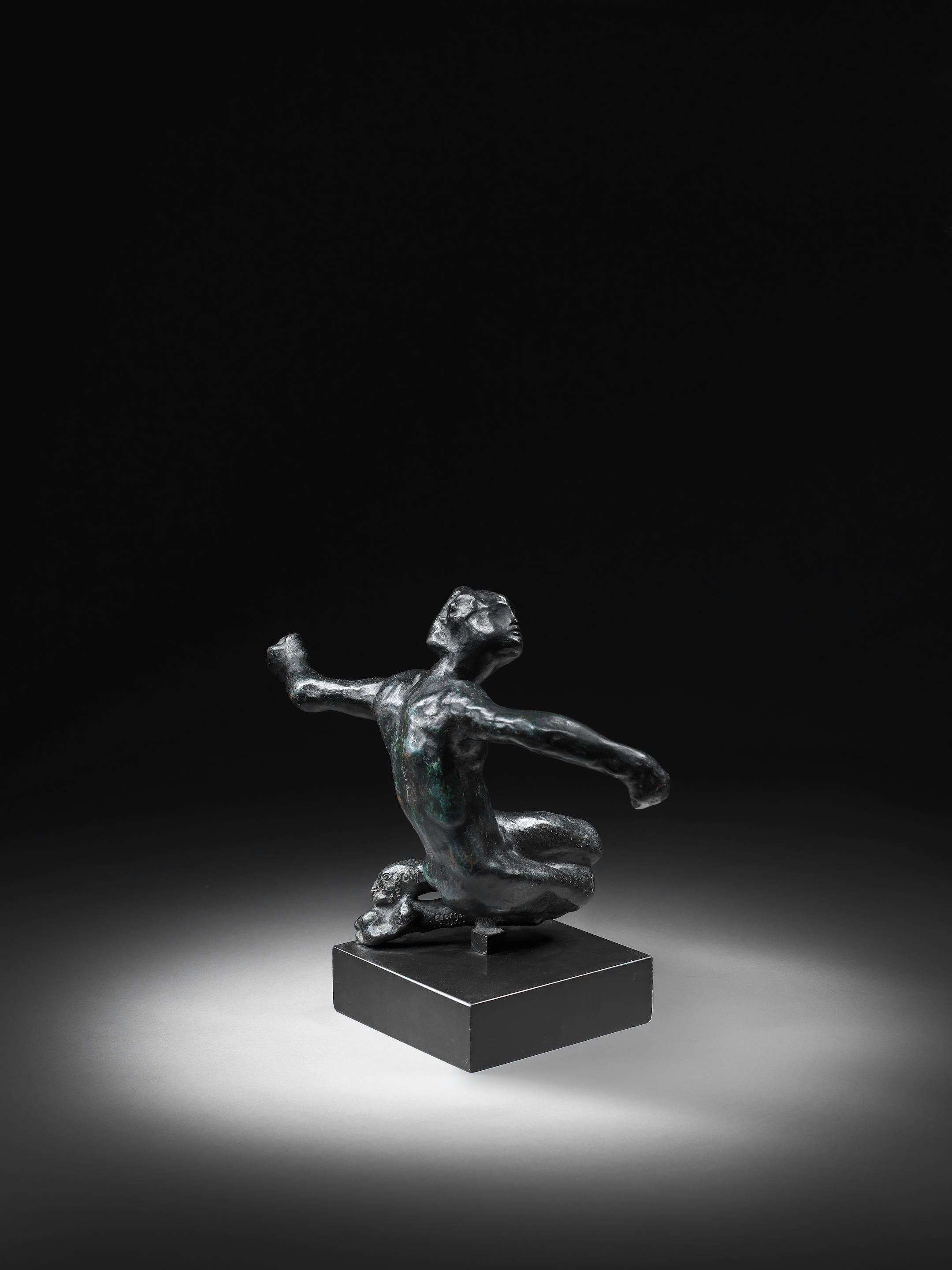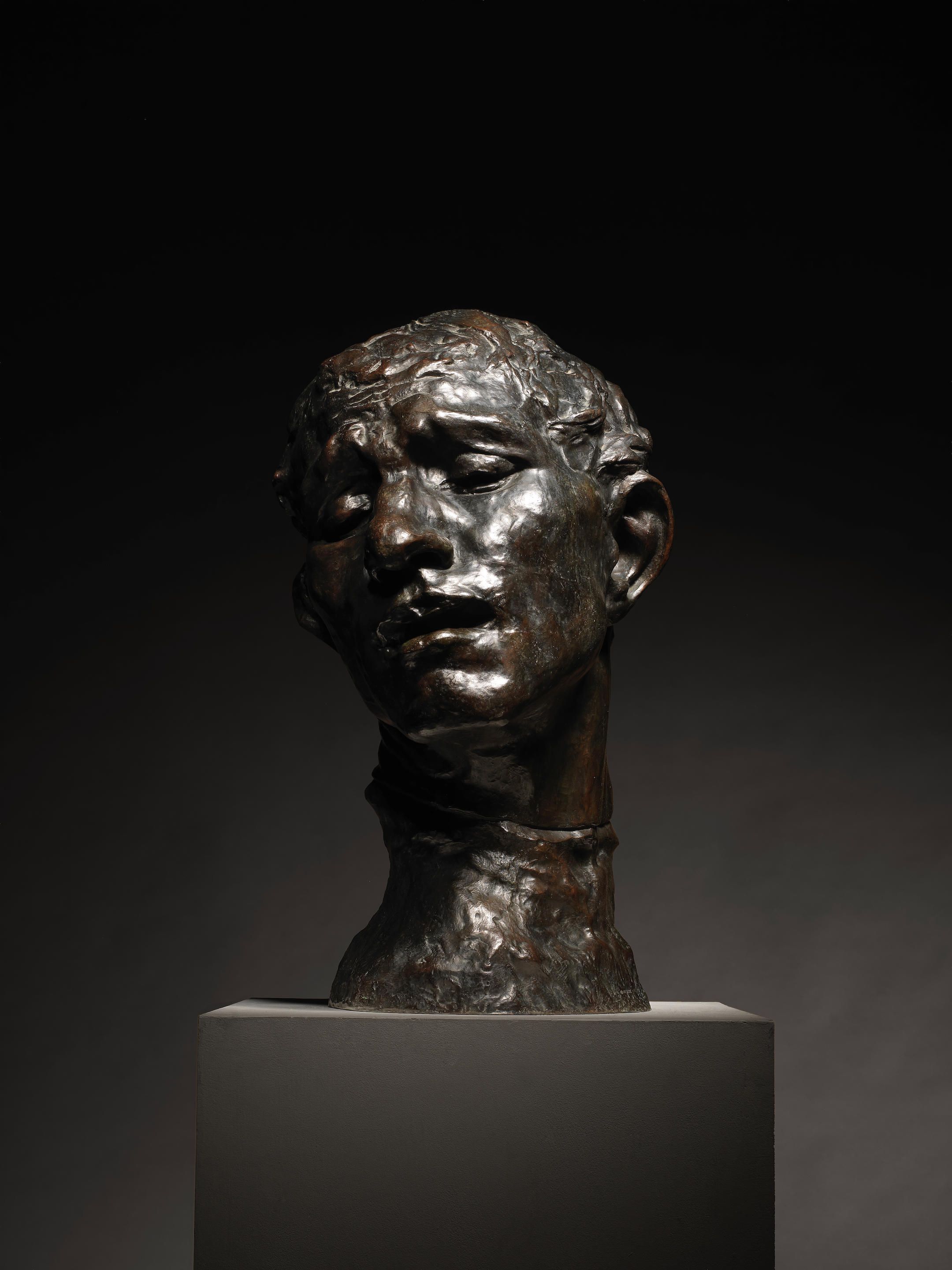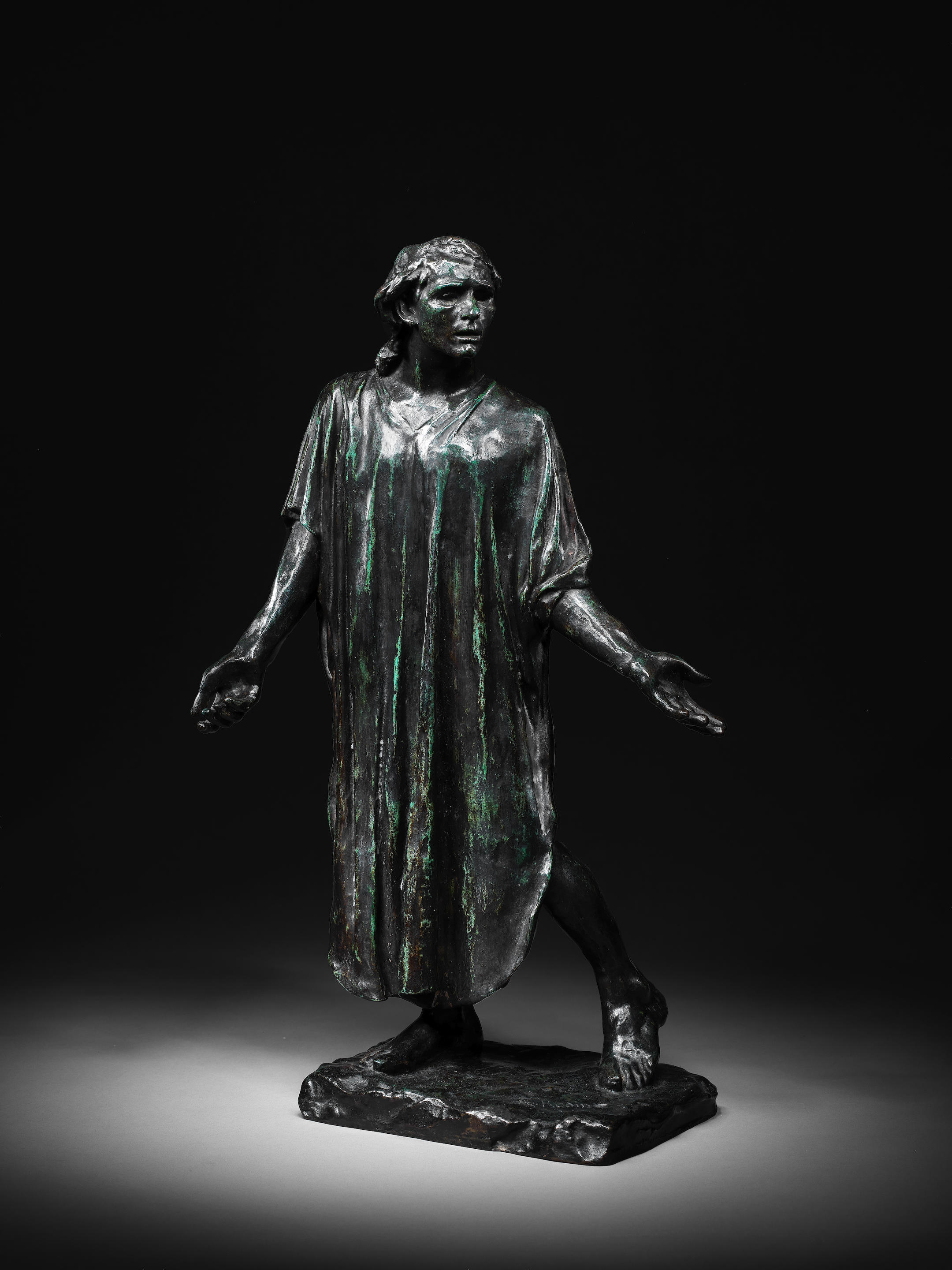AUGUSTE RODIN (1840-1917) L'un des Bourgeois de Calais: Pierre de Wiessant, vêtu, réduction inscribed 'A. Rodin' (on the base) and with the foundry mark 'ALEXIS RUDIER. Fondeur. Paris' (on the side of the base) bronze 17 3/4 in (45 cm) (height) Conceived between 1887-1895, this version reduced in 1895, and cast between 1930-1945 Fußnoten This work will be included in the forthcoming Catalogue Critique de l'Oeuvre Sculpté d'Auguste Rodin currently being prepared by Galerie Brame & Lorenceau under the direction of Jérôme Le Blay under the archive number 2014-4316B. Provenance Philip & Gillian Sher, United States of America, and sold: Bonhams, New York, November 4, 2014, lot 12. Private collection, Pennsylvania (acquired at the above sale). Literature G. Grappe, Catalogue du Musée Rodin, Paris, 1927, nos. 110-115 (illustration of the complete monumental plaster version p. 52). G. Grappe, Catalogue du Musée Rodin, Paris, 1944, no. 167c (illustration of the plaster version p. 60). B. Champigneulle, Rodin, London, 1967, no. 21 (illustration of the complete monumental version p. 66). R. Descharnes & J.-F. Chabrun, Auguste Rodin Lausanne, 1967 (illustration of the complete monumental bronze version p. 114). I. Jianou & C. Goldscheider, Rodin, Paris, 1967 (illustration of the complete monumental bronze version pl. 41). L. Goldscheider, Rodin Sculptures, London, 1970 (illustration of another cast pl. 39, p. 119; illustration of the monumental plaster version pl. 38). J.L. Tancock, The Sculpture of Auguste Rodin Philadelphia, 1976, no. 67-69-13 (illustration of another cast p. 390). A.E. Elsen, Rodin's Art, The Rodin Collection of the Iris & B. Gerald Cantor Center for Visual Arts at Stanford University, New York, 2003, no. 30 (illustration of the monumental version pp. 137-138). A. Le Normand-Romain, The Bronzes of Rodin, Catalogue of works in the Musée Rodin, Paris, 2007, vol. I, no. S.418 (illustration of another cast p. 237). Pierre de Wiessant offers the image of suffering in the extreme. His body, bent, like a taut bow, vibrates with pain, his hands, opening like flowers, sing out.' Antoinette Le Normand-Romain in Rodin: The Burghers of Calais, Paris, 2001, p. 52. With modernization razing Calais' ancient ramparts and the city becoming amalgamated with neighboring townships, the 1884 city council of Calais wanted affirmation of its identity as a historic site. This desire spurred the council to engage Auguste Rodin already a respected sculptor whose winning bid in 1880 to create the Directorate of Fine Arts began his 37 years-long project, The Gates of Hell, to create a sculpture honoring the city. Thus in 1887, Rodin began to conceive of Monument des Bourgeois de Calais. The city council wished for the sculpture to commemorate an episode from the 100 Years War, in which six prominent citizens in 1347 offered themselves as hostages to raise the eleven-month siege of the city by King Edward III of England. Kind Edward's wife, Queen Philippa, upon hearing of this bravery, interceded, and King Edward III spared the town. The council had intended for the work to be a traditional heroic statue of Eustache de Saint-Pierre, leader of the group. Rodin, though, was determined to show all six hostages, not as a narrative group glorifying them, but rather as isolated, suffering individuals that as a collective express their harrowing sacrifice. Indeed, one proposal set the figures close to ground level, a radical idea that set the present-day citizens almost at eye level, with their illustrious forbears seeming to walk among them. Each figure was initially modeled naked and at actual size before being clothed in rough tunics and with the ropes of their captivity around their necks. The figures are shown departing in their tattered clothes to make their sacrifice and surrender themselves to the English Army. The first three figures, including Pierre de Wiessant, were finished by May 1887 and exhibited at Galerie Georges Petit; the full grou
AUGUSTE RODIN (1840-1917) L'un des Bourgeois de Calais: Pierre de Wiessant, vêtu, réduction inscribed 'A. Rodin' (on the base) and with the foundry mark 'ALEXIS RUDIER. Fondeur. Paris' (on the side of the base) bronze 17 3/4 in (45 cm) (height) Conceived between 1887-1895, this version reduced in 1895, and cast between 1930-1945 Fußnoten This work will be included in the forthcoming Catalogue Critique de l'Oeuvre Sculpté d'Auguste Rodin currently being prepared by Galerie Brame & Lorenceau under the direction of Jérôme Le Blay under the archive number 2014-4316B. Provenance Philip & Gillian Sher, United States of America, and sold: Bonhams, New York, November 4, 2014, lot 12. Private collection, Pennsylvania (acquired at the above sale). Literature G. Grappe, Catalogue du Musée Rodin, Paris, 1927, nos. 110-115 (illustration of the complete monumental plaster version p. 52). G. Grappe, Catalogue du Musée Rodin, Paris, 1944, no. 167c (illustration of the plaster version p. 60). B. Champigneulle, Rodin, London, 1967, no. 21 (illustration of the complete monumental version p. 66). R. Descharnes & J.-F. Chabrun, Auguste Rodin Lausanne, 1967 (illustration of the complete monumental bronze version p. 114). I. Jianou & C. Goldscheider, Rodin, Paris, 1967 (illustration of the complete monumental bronze version pl. 41). L. Goldscheider, Rodin Sculptures, London, 1970 (illustration of another cast pl. 39, p. 119; illustration of the monumental plaster version pl. 38). J.L. Tancock, The Sculpture of Auguste Rodin Philadelphia, 1976, no. 67-69-13 (illustration of another cast p. 390). A.E. Elsen, Rodin's Art, The Rodin Collection of the Iris & B. Gerald Cantor Center for Visual Arts at Stanford University, New York, 2003, no. 30 (illustration of the monumental version pp. 137-138). A. Le Normand-Romain, The Bronzes of Rodin, Catalogue of works in the Musée Rodin, Paris, 2007, vol. I, no. S.418 (illustration of another cast p. 237). Pierre de Wiessant offers the image of suffering in the extreme. His body, bent, like a taut bow, vibrates with pain, his hands, opening like flowers, sing out.' Antoinette Le Normand-Romain in Rodin: The Burghers of Calais, Paris, 2001, p. 52. With modernization razing Calais' ancient ramparts and the city becoming amalgamated with neighboring townships, the 1884 city council of Calais wanted affirmation of its identity as a historic site. This desire spurred the council to engage Auguste Rodin already a respected sculptor whose winning bid in 1880 to create the Directorate of Fine Arts began his 37 years-long project, The Gates of Hell, to create a sculpture honoring the city. Thus in 1887, Rodin began to conceive of Monument des Bourgeois de Calais. The city council wished for the sculpture to commemorate an episode from the 100 Years War, in which six prominent citizens in 1347 offered themselves as hostages to raise the eleven-month siege of the city by King Edward III of England. Kind Edward's wife, Queen Philippa, upon hearing of this bravery, interceded, and King Edward III spared the town. The council had intended for the work to be a traditional heroic statue of Eustache de Saint-Pierre, leader of the group. Rodin, though, was determined to show all six hostages, not as a narrative group glorifying them, but rather as isolated, suffering individuals that as a collective express their harrowing sacrifice. Indeed, one proposal set the figures close to ground level, a radical idea that set the present-day citizens almost at eye level, with their illustrious forbears seeming to walk among them. Each figure was initially modeled naked and at actual size before being clothed in rough tunics and with the ropes of their captivity around their necks. The figures are shown departing in their tattered clothes to make their sacrifice and surrender themselves to the English Army. The first three figures, including Pierre de Wiessant, were finished by May 1887 and exhibited at Galerie Georges Petit; the full grou

.jpg)
.jpg)
.jpg)






.jpg)
.jpg)
.jpg)
.jpg)
.jpg)
Testen Sie LotSearch und seine Premium-Features 7 Tage - ohne Kosten!
Lassen Sie sich automatisch über neue Objekte in kommenden Auktionen benachrichtigen.
Suchauftrag anlegen